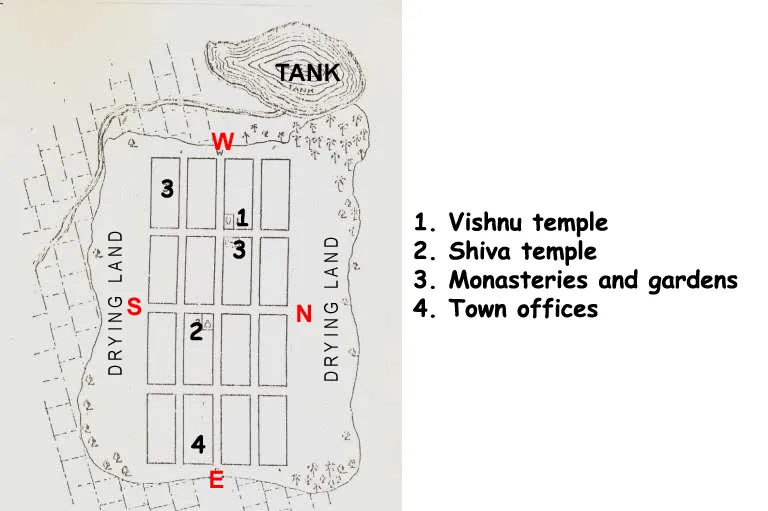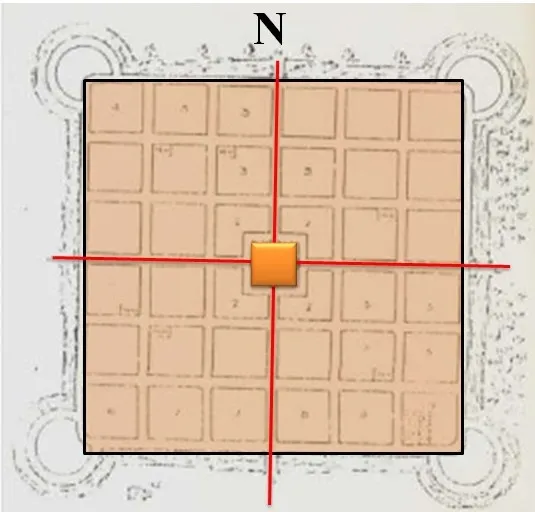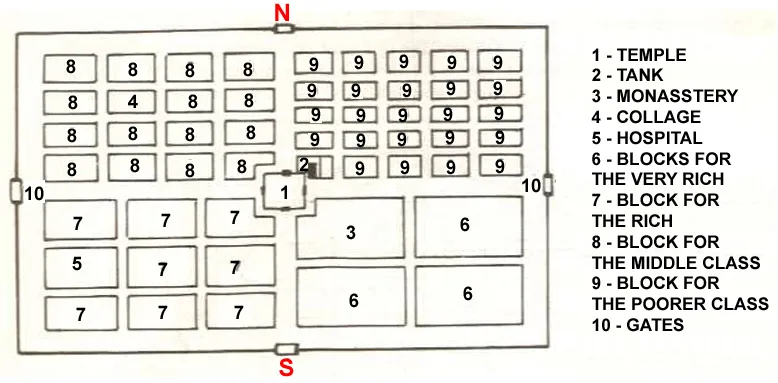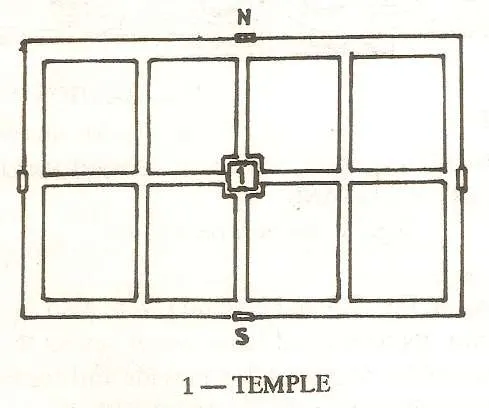If you want to know about the Roman architecture or Indus valley civilization or evolution of Vedic civilization, please click the link.
In ancient India, town planning was considered an important aspect of architecture and was influenced by religious and cultural beliefs.
- The term is used to indicate the arrangement of various components in such a way that the town as such attains significance of a living organism. The town planning was done in scientific footing even in the ancient times.
Planning of a town is dependent on the various factors:
- Soil Type
- Climatic Conditions
- Topography
- Wind Orientation
- Orientation to Take Advantage of Sun and Wind
- The towns were highly influenced by the Site conditions.
- The towns were generally located along the bank of the water body.
- A flowing stream was preferred for Sanitary requirements.
- The towns on the river edge were OBLONG shape; to take maximum advantage of the river.
- Main Street (King/ Raja Marg) were aligned East-West to get roads purified by the Sun’s rays; while the shorter roads were along North – South.
- Roads around the village called Mangal Vithi were reserved for priests.
A typical Indian town consisted of the following:
- Market
- Street
- Public Buildings
- Residences
- Temples
- Royal Palace
- Recreational Centers
- Tank
- City Fort
1) Classification of Ancient Town Planning
(BASIS – Shape and Size Of the TOWN)
There are quite a number of books written by ancient authors about town planning in India. Also known as ‘VASTU SHASHTRA’ (TOWN PLANNING SCIENCE)
- Dandaka
- Sarvathobadra
- Nandyavarta
- Padmaka
- Swastika
- Prastara
- Karmuka
- Chaturmukha
i) Dandaka
Dandaka is a Sanskrit term that refers to a type of town plan shaped like a staff or rod. In ancient Indian town planning, different shapes and designs were used to symbolize different things and to promote specific qualities in the built environment.
The Dandaka town plan was characterized by its straight lines and regularity, which symbolized stability and order. This type of plan was often used in the design of military fortifications and other structures that required a strong and orderly layout. The Dandaka plan was also believed to promote positive energy and to enhance the functionality of the structures it was used in.

- Dandaka, Literally means a village that resemble, a staff. Its streets are straight and cross each other at right angles at the center, running west to east, and south to north.
- This type of town plan provides for two main entrance gates and is generally adopted for the formation of SMALL TOWNS AND VILLAGES.
- Village is Rectangular / Square with street width of street varies from 1-5 danda.
- Village office located in the east.
- Female deity (Gramadevata) will generally be located outside the village, whereas Male deities in the northern portion.
ii) Sarvathobadra
Sarvatobadra is a Sanskrit term that refers to a type of town plan shaped like an umbrella. In ancient Indian town planning, the umbrella shape symbolized protection and shelter. The Sarvatobadra town plan was characterized by its circular shape and radiating streets, which provided a sense of harmony and balance to the built environment.
This type of plan was often used in the design of religious and spiritual structures, such as temples and ashrams, where people sought refuge and peace. The circular shape of the Sarvatobadra plan was also believed to promote positive energy and to enhance the functionality of the structures it was used in.

- This type is applicable to larger villages and towns, which have to be constructed on oblong or square sites.
- The whole town should fully be occupied with HOUSES of various descriptions that should be inhabited by all classes of people.
- Temple dominates the village.
iii) Nandyavarta
Nandyavarta is a Sanskrit term that refers to a type of town plan that is circular with a central square and streets radiating outwards. This type of town plan was commonly used in ancient India, particularly in the design of cities and large settlements. The circular shape of the Nandyavarta town plan symbolized unity and completeness, while the central square served as a gathering place for the community.
The radiating streets provided easy access to different parts of the city and promoted connectivity between the various neighborhoods and areas. The Nandyavarta town plan was also believed to promote positive energy and to enhance the functionality of the structures it was used in.

- Mainly used for construction of TOWNS and not villages.
- Adopted for sites which are either circular or square in shape with 3000-4000 houses.
- The streets run parallel to the central adjoining streets with the temple of the presiding deity in the center of the town.
- Temple of the presiding deity at the center of the town.
- This name is derived from a flower, the form of which is followed in this layout.
iv) Padmaka (Lotus Petals)
Padmaka is a Sanskrit term that refers to a type of town plan shaped like a lotus flower. In ancient Indian town planning, the lotus flower was a symbol of purity, enlightenment, and beauty. The Padmaka town plan was characterized by its circular shape, with streets radiating outwards in a petal-like pattern.
This type of plan was often used in the design of religious and spiritual structures, such as temples and ashrams, where people sought refuge and peace. The circular shape of the Padmaka plan was believed to promote positive energy and to enhance the functionality of the structures it was used in, while the petal-like pattern of the streets added to the overall aesthetic appeal of the built environment.

- This type of plan was practiced for building of the TOWNS with fortress all around.
- Pattern of the PLAN resembles petals of lotus radiating outwards from the center.
- The city used to be an island surrounded by water.
- No scope for expansion.
v) Swastika
Swastika is an ancient Hindu symbol that is widely used in Hindu architecture and town planning. The word “swastika” comes from the Sanskrit word “svastika,” which means “good fortune” or “well-being.” The symbol consists of four arms that are bent at right angles, arranged in a cross-like pattern. The arms are typically of equal length and can be arranged clockwise or counterclockwise.
In Hinduism, the swastika is a powerful symbol of good luck and prosperity. It is often used as a decorative element in Hindu temples, homes, and other structures to bring good fortune and to ward off evil spirits. In ancient Indian town planning, the swastika was used to mark the entrance of a building or town, and to provide a visual representation of the Hindu belief in the cyclical nature of life.

- This type of plan contemplates some diagonal streets dividing the site into certain triangular plots.
- The site may be of any shape.
- The town is surrounded by a rampart wall, with a MOAT at its foot.
- Two main streets cross each other at the center running north to south and west to east.
- Temple is at the centre.
- Jain temple is in south-west cell.
vi) Prastara
Prastara is a Sanskrit term that refers to the arrangement of tiles or stones used in the construction of floors or pavements. In ancient Indian architecture and town planning, the prastara was an important decorative element that was used to create intricate and beautiful patterns on the floors of buildings.

- The characteristic feature of this plan is that the site may be either square or rectangular but not triangular or circular.
- The sites are set apart or the very rich, rich, middle class and poor.
- The size of the site increases according to the capacity of each to purchase or build upon.
- The main roads are much wider when compared to those of other patterns.
- The town may or may not be surrounded by a fort.
vii) Karmuka
This refers to a town plan that is shaped like a bow.

- This plan is suitable for the place where the site of the town is in the form of a bow or semi-circular or parabolic and mostly applied for towns located at sea shores or riverbanks.
- The main streets of the town run from north to south or east to west and the cross streets run at right angles to them. This divides the whole area into BLOCKS.
- Female deity (the presiding deity) is installed in the temple built in any convenient place.
viii) Chaturmukha
Chaturmukha is a Sanskrit term that refers to a building or structure that has four faces or entrances. In ancient Indian town planning and architecture, Chaturmukha structures were used for a variety of purposes, including as temples, gateways, and other religious or secular buildings.
The four faces of a Chaturmukha structure symbolized the four cardinal directions, and were believed to provide protection and access to the building from all directions. The four entrances also allowed for easy flow of people and goods in and out of the structure, promoting connectivity and accessibility.

- This is applicable to all types of towns (from the largest town to the smallest village).
- The site may be either square or rectangular having four faces.
- The town is laid out east to west lengthwise with four main streets.
- The temple of the presiding deity is always at the center.

These principles of town planning in ancient India helped create well-organized, functional, and beautiful towns and cities that were capable of supporting their populations and promoting a sense of community and well-being.
very interesting please post more of similar and related items .